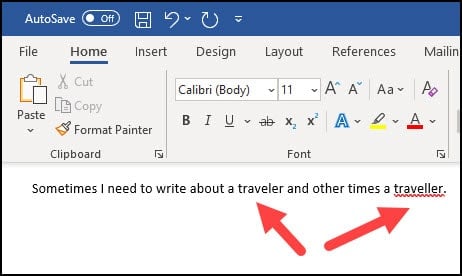Recently, I had to review some proposals. In reading these, I saw several instances where the wrong word was used. This wasn’t a case of word choice, but a typo that a spell checker didn’t flag. People had omitted letters or transposed characters. Think of people using “manger” instead of “manager.” These errors are tough to catch as we tend to skim over these errors when proofing. In this tutorial, I’ll show how to use your exclude dictionary.
For starters, this is a different scenario than when spell check is not working in Word. This is a case where your mistake is a correctly spelled word or brand name. However, we can force Microsoft Word or other Microsoft Office apps to pause and show us the red squiggly lines under these words. This isn’t your typical Microsoft Word dictionary as it works through the other Office apps..
I think of this exclusion dictionary as a safety net, but some people call them “whitelists”, “exception dictionary”, or “ignore lists”.
Microsft Word Dictionary Files
Microsoft Word has three types of dictionary files. The purpose and location differ.
- Main – Large default dictionary for your language.
- Custom – When you click Add during a spell check, that word is added to the default custom dictionary. You can also buy industry-specific custom dictionaries. This is a good place to add brand or company names.
- Exclude – Exception file of words, which always prompts the spell checker. These exclusion terms override the main dictionary.
What to Include in an Exclude Dictionary
I think there are two distinct word groups that go into this file. The first group includes words that you use, and if misspelled, could create an embarrassing scenario. These include words where a letter has been dropped or you pressed the wrong key resulting in an entirely different word or even homonyms. Here are some I spotted:
- pubic (meant public)
- parent (meant patent)
- suing (meant using)
- advice vs advise
- complement vs compliment
The second group of words is situational. For example, a writer needs to switch between British and American spelling based on the client.
Unlike the main dictionary, the words you place in this exclude dictionary prompt the Microsoft Word spell checker. The idea is you’ll look at the flagged word, put it in context, and catch a potential mistake. The file does not update with new software versions. From what I’ve read, these misspellings should not impact Word Readability Statistics since the number of syllables would most likely be the same.
How to Find the Word Exclude Dictionary
- Open Windows File Explorer by pressing your Windows key + E.
- Find your Microsoft UProof folder. In my case, it’s located at C:\Users\Anne\AppData\Roaming\Microsoft\UProof\
- You should see a set of files with a .lex file extension.

- Look at the 2 uppercase letters following ExcludeDictionary. These are language codes such as EN, ES, FR, etc. The numeric codes represent a geographic region. For example, 0409 is a hexadecimal identifier for the United States. You can also consult a Windows Locale Codes table.
⚠ If you don’t see any files, you may have to turn on hidden folders in File Explorer.
How to Edit the Exclude Dictionary File
You’re now ready to add a word exclusion to the exclusion dictionary. There are a few rules.
- You can’t have spaces. No phrases are allowed.
- You can’t have a word that exceeds 64 letters.
- You need to edit the file using a text editor. I’ve used the free editor from Microsoft called VS Code. You can also use Notepad or WordPad.
- Open your .lex file for your language in a text editor. For example, I’ve selected ExcludeDictionaryEN0409.lex since I’m using English in the United States.
- Add one word per line. Each line should be a word you want Microsoft Word to add a squiggly line underneath to catch your attention.

In the list above, you can see where I’ve used words that have different spellings. This is because, in some documents, I need to use US spelling, but not others. I’m telling Microsoft Word to flag them by adding these words, so I am prompted to think about the context.
- Save the file.
- Restart Microsoft Word and do a test paragraph with your exclusion words.
Before I edited the exclusion dictionary, I would just have the red squiggly line under one version of the word.

You can see above that Microsoft Word flagged the British version, but left the American version alone. However, after adding the variations to my exclusion list, I see the desired red squiggly lines.

One item I encountered when adding an exclude dictionary word was timing. This exclusion dictionary works going forward on new content. However, it would not work on existing documents. Also, this feature is available to other Microsoft Office apps.
